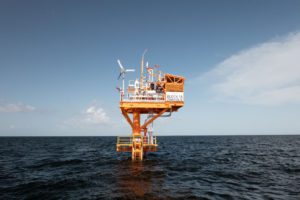
The 100% renewably powered Zandolie Platform in Trinidad and Tobago: A blueprint for sustainable offshore energy
This pioneering renewably-powered offshore platform, that reached first gas within a year of installation, offers a blueprint for rapidly scaling up global offshore energy capacity while reducing the associated costs and carbon emissions.
This project harnessed a light, locally built renewably powered minimum facilities platform to produce up to 40 million cubic feet of gas a day. The Zandolie Field Development was DeNovo’s second offshore instalment and has provided the National Gas Company of Trinidad & Tobago with a stable supply of locally sourced natural gas.
- A lightweight, unmanned modular design that was 100% fabricated in-country, dramatically reducing the cost and carbon emissions from manufacturing, transportation, installation and maintenance.
- Shares a pipeline and processing facility with a neighbouring field, creating a reduced environmental impact from processing.
- Uses only renewable power sources, which translates to no direct CO2 emissions during normal operations.
The Challenge: A low-cost, low-carbon route to rapid first gas
DeNovo faced the challenge of delivering rapid returns and reduced CAPEX and OPEX while simultaneously reducing carbon emissions across the project lifecycle.
This involved the difficulty of producing a 100% renewably powered platform in a region with highly changeable weather conditions that created an energy intermittency risk. Developers also had to contend with the conflicting requirements of having a platform in 20 metres of water in an area with very high-seismic loads and minimising the carbon-intensive steel used in the platform.
Crucially, developers needed to find a lighter alternative to conventional jacketed structures so that the Zandolie field could be sustainably developed using the local manufacturing facilities and installation vessels. Smarter and more streamlined maintenance was also essential to reducing lifecycle emission goals.
The Solution: A circular economy of energy assets
At Aquaterra Energy we aim to drive a global circular economy of energy assets and always look to see if existing platforms, logistics and fabrication facilities can be repurposed or re-used for new offshore energy production. Our Sea Swift platform, using a braced-monopile substructure, provided the perfect solution for this development as it could be rapidly deployed and scaled up using available local resources. It enabled the Zandolie field to be sustainably developed at unprecedented speed – taking just 476,613 manhours of which 66% were local content hours.
The platform will engineered to be entirely renewably self-powered, which eliminated the need for traditional diesel generators or cables connecting to the grid. It adapts to intermittency from local weather fluctuations by using a complimentary combination of wind and solar power, which charge a battery bank providing four days of power cap.
Its streamlined, slimline design used much less steel than conventional jacketed foundations, eliminating the need for larger installation vessels and a reduced reliance on steel, which contributes 8% of global CO2 emissions. To withstand the seismic activity of the region, our engineers harnessed a novel steel bracing system support structure with legs locking monopiles together.
The platform’s modular design meant it could be transported in prefabricated parts and assembled on-site like industrial-scale Lego. The deck, subsea structure and conductor were all installed using the same local jack-up rig that drilled the well without the environmental impact of bringing in bigger vessels and cranes from outside the country.
The “brains” of the platform is the modular deckhouse unit, which houses the main electrical equipment such as the control and shutdown system, wellhead control panel, communications, power distribution panels and solar panels. The modular design of this unit allowed over 90% of commissioning and function testing to be executed onshore in the fabrication yard, which significantly reduced offshore time, cost, and associated CO2 emissions.
This simplified, streamlined design is entirely manufactured locally with existing infrastructure, boosting regional skills and employment while curbing manufacturing-phase emissions, in fact 56.4% was local content spend. A pipeline to the nearby Iguana field enables the platform to share processing facilities with the existing Iguana Platform, delivering further environmental efficiencies, whilst intelligent monitoring and preventative maintenance enables the platform to operate unmanned and reduce average maintenance visits.

Results: A model for sustainably scaling offshore energy
Localisation and decarbonisation of the project from manufacturing to maintenance improved both cost and carbon efficiency – demonstrating that sustainable offshore energy can boost both profit and planet. Platform visits were cut to less than half, when compared to routine visits to traditional platforms and localising material sourcing, fabrication, and installation helped to preserve vital skills for the region.
We believe this project offers a potential blueprint for sustainable offshore development. Similar lightweight, locally built platforms could dramatically reduce the combined CAPEX, OPEX and carbon footprint of offshore oil and gas globally. The Sea Swift range of platforms can be seamlessly scaled up to produce from one up to 10 conductors without increasing installation costs and emissions and due to their customisable design, can be configured for offshore CCS, Hydrogen or Wind developments.
If you think your offshore development could benefit from a Sea Swift platform, get in touch with our team of offshore platform engineers to learn more.